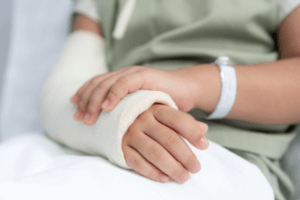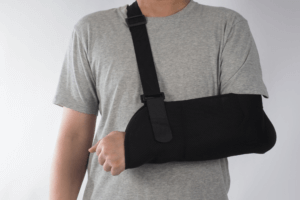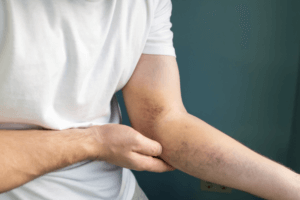
Along with significant pain, arm injuries also bring significant disruption to life. Almost any activity we engage in involves our arms. When they are out of commission, so are we. Do not ignore arm pain after a car accident, and do not wait to connect with a Texas car accident lawyer from The Mejia Law Firm. The costs of an arm injury caused by someone else’s recklessness or carelessness warrant compensation, and we will fight to help you get it.
Steps to Take After Sustaining an Arm Injury
Often, arms experience direct trauma, whether to the elbow, forearm, or shoulder area, in a car accident. Sometimes, victims’ arms slam into part of the vehicle. They may buckle under the force of impact, “ricochet” off part of the car only to smash into another, or sustain deep lacerations–even amputation–if cut by the sharp or twisted metal produced in a vehicle crash.
Injuries such as bone breaks, lacerations, and amputations are immediately apparent and require emergency medical care. Even if your injuries are less obviously severe, do not ignore arm pain. Damage to the soft tissue, nerves, or hairline bone fractures may not seem like an emergency but they can have serious repercussions if not treated.
Pay attention to your arm pain or other symptoms following a car accident. Fast action can save you long-term consequences, and along with keeping your arm in its healthiest form, keep your potential car accident injury claim in top shape as well. Getting medical attention right away can help support your claim and prevent the at-fault party from blaming your injury on your decision to delay care.
Injuries To The Forearm
The forearm is the part of the arm from the elbow to the wrist. The National Library of Medicine (NLM) describes the anatomy of the forearm as including two bones, the ulna and radius, various muscles, five ligaments, and radial nerves. Its functions include moving the elbow, wrist, and fingers.
In addition to breaks in both the ulna and radius, common forearm injuries resulting from car accidents include:
- Ulnar shaft fractures: Breaks in the Ulna on the “pinky side” of the forearm
- Radial shaft fractures: Breaks in the ulna on the thumb-side of the forearm
- Monteggia fractures: A break in the ulna and dislocation of the radius
- Pronator Teres Syndrome: Compression and subsequent aggravation of nerves in the forearm
- Forearm sprain: A tear or tears in forearm ligaments
- Forearm strains: A tear or tears in forearm muscles or tendons
Breaks typically require surgery, a period of time where the forearm must be immobilized (such as in a cast), and a few weeks of rehabilitation. Very serious sprains or strains may require surgery for repair, typically affect mobility, cause pain and swelling, and require extensive recovery periods. Any forearm injury can affect a victim’s ability to work or perform daily activities. These injuries can also cause chronic pain or long-term mobility problems.
Injuries To The Elbow

Common car accident-caused elbow injuries include:
- Elbow fractures
- Elbow dislocation
- Elbow sprains or strains
- Tendonitis or “elbow tendinopathies”
- Bursitis
Elbow injuries frequently involve inflammation and pain in the muscles, connective tissues, and fluid-filled sacs surrounding the joint. They affect the ability to extend the arm outward, bend the arm toward the body, move the arm (palm up) up, and move the arm (palm down) down.
As with forearm injuries, some elbow injuries require surgery and rehabilitation. Others may only need rehabilitation and rest. The injury and recovery interventions have a high probability of disrupting your life.
Injuries To The Upper Arm
The elbow joint to the shoulder joint is the upper arm. This area includes three “front” muscles (the brachialis, coracobrachialis, and biceps brachii) and one back muscle (the triceps brachii). One long bone, the humerus, extends from the shoulder to the elbow.
The upper arm muscles allow you to bring your arm toward your body, extend or straighten the forearm at the elbow, flex the arm at the elbow (picture a “muscleman” move), move the top part of the arm at the shoulder point, raise your arms above your head, and turn your hand to the palm-up position. These functions are essential for daily living and work. Damage, whether temporary or permanent, comes with probable wage loss, inconvenience, pain, and other expenses, and a skilled Texas car accident attorney from The Mejia Law Firm will fight to help you recover those losses.
Common upper-arm injuries from a car accident include:
- Strain to the bicep or tricep muscles
- Humerus bone fracture: A break in the upper arm bone
- Humerus dislocation: A shift in the upper arm bone
- Brachial plexus injuries: Damage to the brachial plexus nerve bundle which travels from the neck through the shoulder and down the arm
Injuries To The Shoulder
The shoulder, also known as the glenohumeral joint, is a ball and socket joint similar to the hip joint. It has the most extensive range of motion in the body, connecting the humerus bone to the shoulder blade. The shoulder’s functions include moving the arms away from or toward the body, moving the arms front to back, in a rotational movement, and overhead.
According to the Cleveland Clinic, the shoulder is comprised of four rotator-cuff muscles, rhomboid muscles that help lift the shoulder blades, trapezius muscles for lowering and lifting the shoulders, and deltoid muscles that allow forward, backward, and side arm movement. Because the shoulder is so flexible, its muscles and soft tissue experience wear and tear over time in normal circumstances. The impact of a car accident can create an immediate injury.
Should injuries sustained in a car accident can include:
- Sprains that damage the shoulder ligaments
- Dislocation in the humerus or should-blade bones
- Shoulder labrum tear
- Rotator cuff or other muscle tears
- Brachial plexus injuries
Be Aware of Symptoms

- Limited mobility
- Bruising or other discoloration
- Wrist, elbow, or shoulder pain
- Swelling
- Warmth or redness
- Muscle spasms
- Numbness or tingling in your fingers, wrist, elbow, or neck
- “Cracks” or “pops” when you move your arms
Never downplay your symptoms. It is better for your health and your injury case to play it safe and see a doctor. Get the treatment you need and the compensation you deserve.
Get Compensated for Your Arm Injuries from a Car Accident
The Mejia Law Firm fights for victims’ rights. That means we work to hold those who caused your injury accountable for compensating you for the losses and pain you have experienced because of that injury. An experienced, attentive Texas car accident lawyer from our team is ready to meet with you. Call or send a message to tell us about your case and set up a free consultation. We are at your service.
